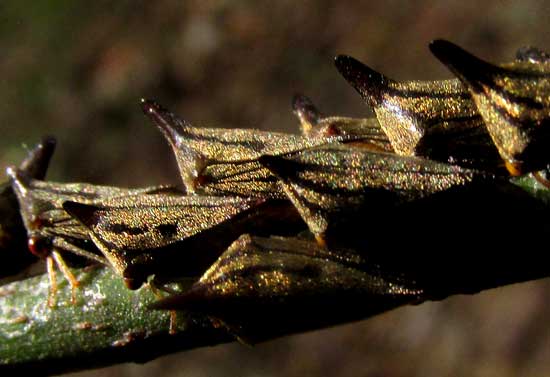Excerpts from Jim Conrad's
Naturalist Newsletter
from the February 25, 2018 Newsletter issued from Rancho Regenesis in the woods ±4kms west of Ek Balam Ruins; elevation ~40m (~130 ft), N20.876°, W88.170°; north-central Yucatán, MÉXICO
A BRISTLING CLUSTER OF THORN BUGS
A wildflower's smooth stem overarching the shadowy dirt trail leading into the rancho caught my attention because it appeared to bear a compact cluster of brown, broad-based spines of the kind on blackberry canes. Spines don't cluster like this, so I took a closer look, and saw what's shown below:

They're insects in the "True Bug Order," the Hemiptera, with sucking mouthparts, like cicadas, aphids and leafhoppers. Happily, I have a friend in Quebec with a special interest in this group, so I sent the picture to him.
Gilles thought that our spinelike bugs belonged to the Treehopper Family, the Membracidae, most likely the subfamily Membracinae. Treehoppers shaped like our bugs are called thorn bugs. About 3200 species of treehoppers in over 400 genera are known, so we're still far from having a name for the species in the picture. However, working just with a photo taken in heavy shade, narrowing it down to "probably Membracinae" is pretty good. Maybe eventually an expert doing a Web search on the keywords "Yucatan Membracinae" will be glad to see our picture, and maybe help us get it to genus or even species.*
Bugs in this family pierce plant stems with their beaks and feed on sap. Excess sap taken into their bodies becomes concentrated as honeydew, which attracts ants, which may help provide protection to the bugs from predators. This kind of relationship where both parties benefit is known as mutualism.